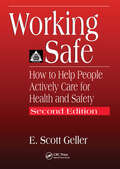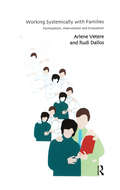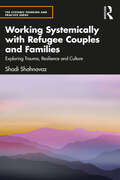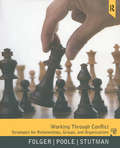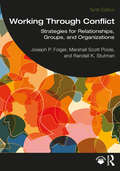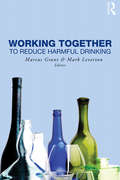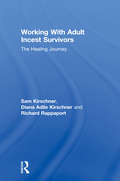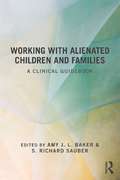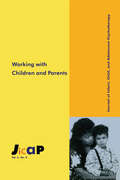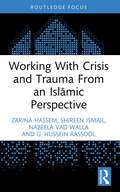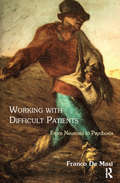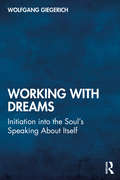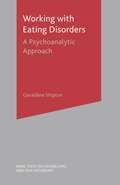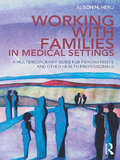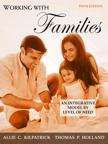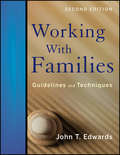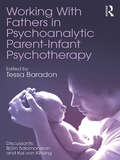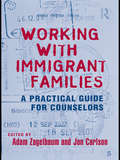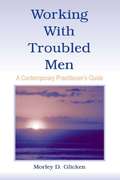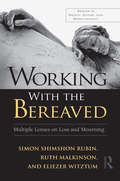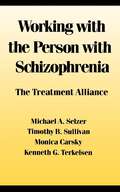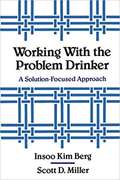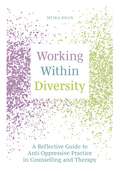- Table View
- List View
Working Safe: How to Help People Actively Care for Health and Safety, Second Edition
by E. Scott GellerWritten by world-renowned health and safety researcher E. Scott Geller, Working Safe: How to Help People Actively Care for Health and Safety, Second Edition presents science-based and practical approaches to improving attitudes and behavior for achieving an injury-free work environment. This book teaches proactive applications of behavior-based psychology for improving health and safety. Relevant theory and principles are clearly explained and practical step-by-step procedures are detailed. Dr. Geller's anecdotal and non-academic writing style makes the book fun and easy to read.This research-based text is completely updated and expanded from the 1996 edition. It includes three new chapters: one on behavioral safety analysis, another on intervening with supportive conversation, and the third on how to promote high performance teamwork. Thus, this second edition continues to provide the practical advice safety leaders rely on.Working Safe: How to Help People Actively Care for Health and Safety supplies the research and theory needed to customize effective behavior-based procedures and tools in your workplace. The information and examples provide health and safety professionals with behavioral science methods capable of enhancing safety awareness, reducing at-risk behavior, and facilitating ongoing participation in safety-related activities.
Working Systemically with Families: Formulation, Intervention and Evaluation
by Rudi Dallos Arlene VetereSystemic theory offers a valuable framework for integrating the diverse ideas found throughout the mental health arena in both theory and clinical practice. With this accessible book, the authors take you on an enjoyable and coherent journey through systemic theory. They then review the body of research into family therapy and conclude with a critical review of major recent developments in theory and application. At the end of several chapters are reflexive notes containing exercises that relate to the ideas and processes found within the chapter to further develop the reader's understanding. The conclusion draws together the ideas found throughout the book, with particular emphasis on the interlocking triangle of formulation, intervention and evaluation and how this will impact on systemic practice in the future. While this book will be an invaluable introduction to family systems theory and practice for clinical psychology training courses, plugging a gap that the authors have identified as one of their motives for writing it, its remit runs much wider. It will prove an essential companion for any professional working in the public services, whether systemically trained or not.
Working Systemically with Refugee Couples and Families: Exploring Trauma, Resilience and Culture (The Systemic Thinking and Practice Series)
by Shadi ShahnavazThis stirring and insightful book explores how family dynamics among refugees are affected by the trauma of forced migration. Written by an experienced family therapist, it uses a systemic perspective to understand the impact on couple relationships and parenting, as well as the broader issue of cultural and social assimilation. Shedding light on the complex and relational nature of the trauma experienced by refugee families, including issues around gender and mental health, Shadi Shahnavaz examines the clinical implications for those who care for them. The unique, in-depth interviews with refugees provide a rare insight into their journey to England and the adverse experiences they encounter along the way. Rather than a simple reflection on practice, Shahnavaz invites the reader to think about the ways in which they can connect with others, even in challenging and unfamiliar situations. Working Systemically with Refugee Couples and Families is essential reading for any therapist or counsellor working today.
Working Through Conflict: Strategies for Relationships, Groups, and Organizations
by Marshall Scott Poole Joseph Folger Randall K. StutmanUpdated in its 7th edition, Working Through Conflict provides an introduction to conflict and conflict management that is firmly grounded in current theory, research, and practice, covering the whole range of conflict settings (interpersonal, group, and organizational). Encompassing a broad spectrum of theoretical perspectives, the text includes an abundance of real life case studies that illustrate key concepts and help students learn how to apply theory. The book's emphasis on application of concepts makes it highly accessible to students, while expanding their understanding of both conflict theory and practical skills.An introduction to social science research and theory on conflict
Working Through Conflict: Strategies for Relationships, Groups, and Organizations
by Marshall Scott Poole Randall K. Stutman Joseph P. FolgerEncompassing theory, research, and practice, this tenth edition provides an introduction to conflict communication and conflict management. This text features real-life case studies across a range of theoretical perspectives and conflict settings, including interpersonal, group, and organizational. Approachably written for students and with an eye to application, the book teaches conflict theory in the context of practical skills. This edition features new sections and references on recognizing intractable conflict and managing online conflict, a new exhibit on conflict escalation, and a new section on interpersonal goals, as well as an updated list of powerful ways to resolve and manage conflict.This textbook is ideally suited to undergraduate or graduate courses on conflict communication within communication studies, business and management, political science, and counseling programs. An Instructor’s Manual, including a sample syllabus, written and oral assignments, cases, exercises, video and online resources, sections from previous editions, and test questions is available at www.routledge.com/9781032489186.
Working Through Synthetic Worlds
by Kenneth W. KisielVirtual environments (VE) are human-computer interfaces in which the computer creates a sensory-immersing environment that interactively responds to and is controlled by the behaviour of the user. Since these technologies will continue to become more reliable, more resolute and more affordable, it's important to consider the advantages that VEs may offer to support business processes. The term 'synthetic world' refers to a subset of VEs, having a large virtual landscape and a set of rules that govern the interactions among participants. Currently, the primary motivators for participation in these synthetic worlds appear to be fun and novelty. As the novelty wears off, synthetic worlds will need to demonstrate a favourable value proposition if they are to survive. In particular, non-game-oriented worlds will need to facilitate business processes to a degree that exceeds their substantial costs for development and maintenance. Working Through Synthetic Worlds explores a variety of different tasks that might benefit by being performed within a synthetic world. The editors use a distinctive format for the book, consisting of a set of chapters composed of three parts: ¢ a story or vignette that describes work conducted within a synthetic world based loosely on the question, 'what will work be like in the year 2025?', founded on the expert authors' expectations of plausible future technologies ¢ a scholarly review of the technologies described by the stories and the current theories related to those technologies ¢ a prescription for future research required to bridge the current state-of-the-art with the notional worlds described in the stories. The book will appeal to undergraduate and graduate students, professors, scientists and engineers, managers in high-tech industries and software developers.
Working Together to Reduce Harmful Drinking
by Marcus Grant Mark LevertonThis book is intended to contribute to the World Health Organization’s (WHO) global strategy to reduce the harmful use of alcohol. It explores areas where alcohol producers’ technical competence can and does make a positive contribution to reducing harmful drinking and where industry input has been welcomed by WHO. The book describes each of these areas: producing beer, wine, and spirits; addressing availability of noncommercial beverages; pricing, marketing, and selling beverage alcohol; encouraging responsible choices; and working with others. The final chapter sets out views of how alcohol producers can contribute to reducing harmful drinking in countries where they are present. The messages recurring throughout the book are that reasonable regulation provides the context for good alcohol policy, excessive regulation often leads to unintended negative consequences, leading producers have a proud record of making positive contributions to implementing effective alcohol policies - but there are opportunities to do much more.
Working With Adult Incest Survivors: The Healing Journey
by Sam Kirschner Diana Adile Kirschner Richard RappaportFirst published in 1993. Routledge is an imprint of Taylor & Francis, an informa company.
Working With Alienated Children and Families: A Clinical Guidebook
by Amy J. L. Baker S. Richard SauberThis edited volume is written by and for mental health professionals who work directly with alienated children and their parents. The chapters are written by leaders in the field, all of whom know how vexing parental alienation can be for mental health professionals. No matter how the professional intersects with families affected by alienation, be it through individual treatment, reunification therapy, a school setting, or support groups, he or she needs to consider how to make proper assessments, how to guard against bias, and when and how to involve the court system, among other challenges. The cutting edge clinical interventions presented in this book will help professionals answer these questions and help them to help their clients. The authors present a range of clinical options such as parent education, psycho-educational programs for children, and reunification programs for children and parents that make this volume a useful reference and practical guide.
Working With Children: Journal of Infant, Child, and Adolescent Psychotherapy, 2.2
by Kirkland C. VaughansThis is a special issue of JICAP looking at working with children and parents.
Working With Crisis and Trauma From an Islāmic Perspective (Islamic Psychology and Psychotherapy)
by G. Hussein Rassool Zarina Hassem Shireen Ismail Nabeela Vad WallaWorking with Crisis and Trauma from an Islāmic Perspective provides a holistic framework and treatment methods for working with trauma and crises, framed within an Islāmic Psychology paradigm.This book begins by conceptualising trauma and existing models of understanding treatment, and then places trauma and crises within an Islāmic viewpoint. The authors focus on the Qur’â, the Sunnah, and Islāic Psychology to rationalise and explain the effects of trauma and how it presents while proposing treatment methods within this context. The final chapter uses case studies to illustrate practical applications and includes coping strategies directly from authentic Islāic sources, and the sixth chapter focuses on the legacy of trauma in terms of post‑raumatic growth.This book will be essential reading for professionals in the fields of psychology and mental health looking to understand how Islāic Psychology practices can be presented as a treatment intervention for patients experiencing trauma and gain insight into how to incorporate these protocols into their own practice.
Working With Difficult Patients: From Neurosis to Psychosis
by Franco De MasiIn this book the author examines the series of connections that give rise to the intimate relationship between environment and individual in the construction of emotional suffering, emphasising both the undisputed pathogenic action of environmental stimuli and the active participation of whoever is obliged to suffer the negative situation. The author shows that the way in which one tries to escape suffering is what often seriously jeopardises growth. Working with Difficult Patients points out the intrinsic link between some forms of mental suffering and the distorted responses that the patient has received from his or her original environment. For this reason the author explores the concept of the emotional trauma in particular, since this trauma, which occurs in the primary relationship, often impels the child into relational withdrawal and towards constructing pathological structures that will accompany him or her for the rest of their life. The chapters are ordered according to a scale of increasing treatment difficulty, which is proportional to the potential pathogenicity of the underlying psychopathological structure.
Working With Dreams: Initiation into the Soul’s Speaking About Itself
by Wolfgang GiegerichThis book is about the practice of working with dreams. Rather than presenting a general theory about dreams, it focuses on the dream as phenomenon and raises the question how we must look at dreams if our approach is supposed to be a truly psychological one. So far most essays on, and the practice of, Jungian dream interpretation have paradoxically centered around the person of the dreamer and not around the dream itself. Dreams were used as a means to understand the analysand and what is going on in him or her. Jung’s fundamental shift from his earlier person-based psychology and pre-alchemy stance to his mature soul-based psychology, informed by the hermetic logic of alchemy, has not been followed, which was already noted by Jung himself: "My later and more important work (as it seems to me) is still left untouched in its primordial obscurity." The present study is based decidedly on the stance of mature Jung and his very different views about dreams. His most crucial insights in this regard include that in dreams the soul speaks about itself (not about the dreamer), that the dream is its own interpretation and therefore needs to be circumambulated (rather than translated into the language of psychology and everyday life), and that dream images have everything they need within themselves (rather than needing associations from the dreamerʼs daily life). This book discusses in detail what all this means in practice and what it demands of the psychologist. A decisive transposition away from ordinary consciousness, a "crossing to the other side of the river," is required of the consciousness that wants to approach dreams psychologically. Numerous aspects of dreams and special questions that come up in working with dreams are discussed. At the end of this book our working with dreams is situated in the wider question of the psychological task in general by exploring Jungʼs insistence that psychology has to transcend the "consulting room," Hillman’s move "From mirror to window" and, in Plato’s parable, the revolutionary move out of, and return to, "the cave." While limited to the topic of dreams this book may also serve as an indirect introduction to an understanding of psychology as a "psychology with soul" (Jung) or as the discipline of interiority.
Working With Eating Disorders: A Psychoanalytic Approach (Basic Texts in Counselling and Psychotherapy)
by Geraldine ShiptonEating disorders such as anorexia and bulimia are increasingly prevalent in today's society and of great concern to a wide range of health-related professionals, including counsellors and psychotherapists. This important new text, written in an intelligent yet accessible style, provides an authoritative and practical introduction to therapeutic work with this large client group. Taking a psychodynamic approach, Working with Eating Disorders also embraces an appreciation of cultural influences and uniquely illustrates the context of eating disorders in today's society.
Working With Families in Medical Settings: A Multidisciplinary Guide for Psychiatrists and Other Health Professionals
by Alison M. HeruWorking With Families in Medical Settings provides mental-health professionals with the tools they need to figure out what patients and families want and how, within the constraints imposed by 21st-century healthcare setting, to best give them the care they need. Psychiatrists and other clinicians who work in medical settings know that working with a patient with a chronic illness usually entails work with that patient’s family as well as with other medical professionals. Some families need education; others have specific difficulties or dysfunctions that require skilled assessment and intervention. It is up to the clinician to find productive ways to work with common themes in family life: expressed emotion, levels of resilience, life-cycle issues, and adaptation to illness, among others. Enter Working With Families in Medical Settings, which shines a spotlight on the major issues professional caregivers face and shows them how to structure an effective intervention in all kinds of settings. Psychiatrists, particularly those in psychosomatic medicine, and other clinicians who work with the medically ill will find Working With Families in Medical Settings to be an essential resource and guide to productive relationships with patients and their families.
Working With Families: An Integrative Model By Level Of Need (Fifth Edition)
by Allie C. Kilpatrick Thomas P. HollandThis text focuses on all levels of need within a family, and provides clear guidelines for effective family interventions. The authors emphasize family strengths, coping capacities, and the many commonalities shared by all. All levels of need are addressed and practice models are applied, highlighting the importance of looking at the specific needs of each family and the effective practice interventions.
Working With Families: Guidelines and Techniques
by John T. EdwardsA complete guide for helping professionals, with tried-and-true techniques for practicing family counseling therapyNow in its second edition, Working With Families: Guidelines and Techniques is filled with up-to-date, systems-oriented techniques focused on field-tested results. Outlining the dos and don'ts of working with different types of families and the various complications, nuances, and complexities that can occur, this practical guide provides a broad and proven selection of interventions, processes, and guidelines for working interactively, systematically, and compassionately with families.Working With Families, Second Edition covers a range of topics including:Family work in different settingsSession-by-session guidelinesTherapeutic themes by family typeManaging adolescents in family sessionsDealing with fear of family workFamily mappingStrategic child assessmentChemical dependence and its impact on familiesInformed by the author's many years of experience in the field, both as a clinician and as a trainer, Working With Families, Second Edition offers an invaluable systems-oriented, goal-directed, problem-solving approach to family counseling therapy for all mental health professionals.
Working With Fathers in Psychoanalytic Parent-Infant Psychotherapy
by Tessa BaradonWorking With Fathers in Psychoanalytic Parent-Infant Psychotherapy interfaces theoretical ideas about fatherhood and their incorporation into the clinical practice of psychoanalytic parent-infant psychotherapy. Often, when a family attends parent-infant psychotherapy, issues of the father are eclipsed by attention to the mother, who is usually the identified patient. Until now relatively neglected in the literature, this book attends to both the barriers to psychological work with the father, and to ways in which he can be engaged in a therapeutic process. In this book, Tessa Baradon brings together some of the most eminent clinicians and academics in the field of parent-infant psychotherapy, in a layered collection of theoretical and clinical contributions. She and her co-discussants, Björn Salomonsson and Kai von Klitzing, conclude with an integration and critique of the themes presented, exploring the ideas of their fellow contributors and expanding on the central themes of the work. Working With Fathers in Psychoanalytic Parent-Infant Psychotherapy will be of interest to mental health practitioners working with infants, who will learn that each individual and the family as a system can benefit from such an inclusive approach.
Working With Immigrant Families: A Practical Guide for Counselors (Routledge Series on Family Therapy and Counseling)
by Adam ZagelbaumThis book aims to create a foundation that respects theory, culture, and the mental health professions and to initiate the practical and needed discussions about how to work with immigrant families.
Working With Traumatized Youth In Child Welfare (Social Work Practice With Children And Families)
by Nancy Boyd Webb James R. DumpsonUntil recently, there has not been a great deal of overlap in the child welfare and trauma literatures. This text bridges that divide by integrating perspectives from both fields to help practitioners understand and address the special needs of maltreated children and adolescents and their families. Current knowledge on attachment, trauma, and risk and resilience is clearly explained, including the impact of abuse on the brain. Readers learn how to conduct assessments and implement a range of effective helping strategies with youth in foster care and other settings. Featuring extensive case illustrations, the book gives particular attention to diversity issues and the importance of supporting child and family strengths.
Working With Troubled Men: A Contemporary Practitioner's Guide
by Morley D. GlickenThis book offers a concise, readable, research-grounded synthesis of the special concerns mental health and other helping professionals need to address when working with men today, and explains a wealth of effective gender-specific approaches to assessment and intervention that result in more successful outcomes for male clients.Many more women than men seek counseling and therapy, and to some extent standard services have evolved in response to female styles of communicating and problem-solving. Practitioners frequently feel frustrated and baffled by their male clients because they seem unresponsive to treatment approaches that work so well for women. But many men benefit from therapy when practitioners understand male socialization and the ways men communicate and problem-solve.Too many men today are doing badly and are in real need of help. Almost half of America's male children grow up in single parent homes headed by mothers, where they seldom have male mentors or role models. Fewer men than women attend or graduate from college, and increasing levels of binge drinking and date rape on campuses paint a discouraging picture of men on campus. Male violence continues to be a serious problem in many American communities, with male youth violence continuing at epidemic levels. Men die younger than women overall and in much higher proportions from suicide, homicide, and cirrhosis of the liver.
Working With the Bereaved: Multiple Lenses on Loss and Mourning (Series in Death, Dying, and Bereavement)
by Eliezer Witztum Simon Shimshon Rubin Ruth MalkinsonWorking With the Bereaved summarizes the major themes in bereavement research and clinical work and uses the authors’ own cutting-edge research to show mental-health practitioners how to integrate these themes into their practice. It provides clinicians with a framework for exploring their own emotional and intellectual assumptions about loss and bereavement, and it goes on to summarize state-of-the-art thinking in the field. The heart of the book focuses on the theoretical and clinical implications of the empirically validated Two-Track Model of Bereavement, as well as a variety of therapeutic techniques designed to help the bereaved both reapproach life and manage their continuing bonds with the deceased. The later chapters examine methods for integrating systems and family perspectives in therapy, for attending to the implications of culture and religion, and for meeting crises and emergencies in bereavement care. The concluding chapter addresses self-care, well-being, and resilience, offering practical guidelines for both the bereaved and those who treat them.
Working With the Person With Schizophrenia: The Treatment Alliance
by Michael SelzerBrilliant and insightful, Dr. Michael Selzer and his colleagues offer a radical perspective on understanding and treating the schizophrenic person. The person with schizophrenia poses a formidable challenge even to the experienced clinician. Bizarre, unpredictable behavior, disordered thought patterns, peculiar, even unintelligible speech, and extreme distrust can drastically limit the clinician's ability to conduct therapy. It is often seemingly impossible to determine the cause of these behaviors: Are they a result of the disease, the side effects of drugs, or the patient's efforts to cope? What is often lacking is a clear understanding of the patient's own experience of his world. Without a realistic appraisal of the patient's physiological and psychological vulnerabilities, the effect of various stresses on him, and his own unique adaptation to these circumstances, no effective drug or psychotherapeutic treatment intervention is possible. Thoughtful, intelligent, and acutely perceptive, Working with the Person with Schizophrenia is a major breakthrough for working with persons with this condition. The authors have shown that therapy with the schizophrenic person is not only possible but highly rewarding.
Working With the Problem Drinker: A Solution-Focused Approach
by Scott D. Miller Insoo Kim Berg Insoo BergAt a time when the accepted standard treatment for alcoholism is long-term and expensive, solution-focused therapy, as developed at the Brief Family Therapy Center in Milwaukee, offers a brief and cost-effective alternative. Insoo Kim Berg and Scott D. Miller believe that a focus on solutions, rather than pathology, is the most constructive strategy for working with problem drinkers; their foremost concern is with what works. To this end they don't reject traditional treatment programs; rather, they view them as one part of a flexible and multidimensional approach to alcohol abuse treatment. <p><p> The authors successfully utilize solution-focused therapy in their work with problem drinkers, but it is their philosophy of working with clients―and within clients' belief systems―to encourage change that is at the heart of their model. The model, grounded in the philosophy of solution-focused brief therapy, introduces a paradigmatic change in the approach to substance abuse treatment. Rather than treating a problem drinker, Berg and Miller work with clients to treat problem drinking. The authors' refreshing blend of respect for their clients and optimism about their ability to stop abusive drinking offers hope to clients who can't fit into traditional long-term programs or who have given up on themselves. This book shows how clients can be helped to construct a future where drinking or substance abuse is no longer a problem. <p><p> Solution-focused therapy, based on respect for and collaboration with the client, concentrates on success and solutions. Therapists develop goals with the client, rather than imposing "appropriate" treatment objectives. If one solution doesn't work, the technique―not the client―is blamed and client and therapist go on to "do something different." The authors' model is much more than a list of interventions; it is a multi-faceted approach to treatment, which can adapt to anything that works, whether brief therapy, AA, or more formal inpatient programs.
Working Within Diversity: A Reflective Guide to Anti-Oppressive Practice in Counselling and Therapy
by Myira KhanIn this reflective guide, Myira Khan tackles what it means to work within diversity as a therapist - to actively reflect on your own identity and experiences and how they affect the therapeutic relationships between you and your clients. Presenting a model of anti-oppressive practice, the book examines topics such as power and privilege, cultural humility and how professionals can work to remove barriers to counselling and therapy. It focuses specifically on race, ethnicity and faith, while also considering the implications of intersectional identities. The workbook elements of this book encourage self-reflection and the implementation of new ideas within the therapeutic process. There is an emphasis on practical application throughout the book and it will inspire readers to consider what 'working within diversity' and working cross-culturally really looks like in the therapy room itself.
